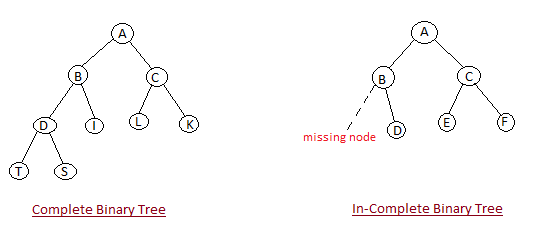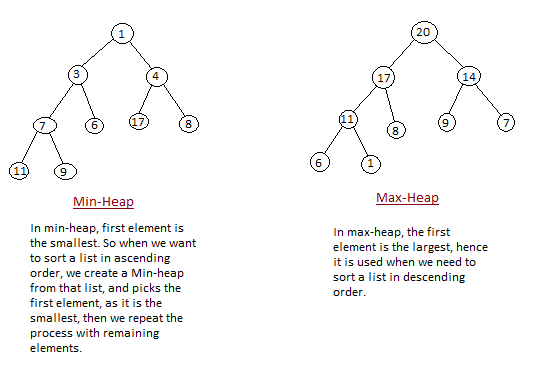Heap Sort Algorithm
Heap Sort is one of the best sorting methods being in-place and with no quadratic worst-case running time. Heap sort involves building a Heap data structure from the given array and then utilizing the Heap to sort the array.
You must be wondering, how converting an array of numbers into a heap data structure will help in sorting the array. To understand this, let's start by understanding what is a Heap.
What is a Heap ?
Heap is a special tree-based data structure, that satisfies the following special heap properties:
- Shape Property: Heap data structure is always a Complete Binary Tree, which means all levels of the tree are fully filled.

- Heap Property: All nodes are either greater than or equal to or less than or equal to each of its children. If the parent nodes are greater than their child nodes, heap is called a Max-Heap, and if the parent nodes are smaller than their child nodes, heap is called Min-Heap.

How Heap Sort Works?
Heap sort algorithm is divided into two basic parts:
- Creating a Heap of the unsorted list/array.
- Then a sorted array is created by repeatedly removing the largest/smallest element from the heap, and inserting it into the array. The heap is reconstructed after each removal.
Initially on receiving an unsorted list, the first step in heap sort is to create a Heap data structure(Max-Heap or Min-Heap). Once heap is built, the first element of the Heap is either largest or smallest(depending upon Max-Heap or Min-Heap), so we put the first element of the heap in our array. Then we again make heap using the remaining elements, to again pick the first element of the heap and put it into the array. We keep on doing the same repeatedly untill we have the complete sorted list in our array.
In the below algorithm, initially
heapsort() function is called, which calls heapify() to build the heap.Implementing Heap Sort Algorithm
Below we have a simple C++ program implementing the Heap sort algorithm.
/* Below program is written in C++ language */
#include <iostream>
using namespace std;
void heapify(int arr[], int n, int i)
{
int largest = i;
int l = 2*i + 1;
int r = 2*i + 2;
// if left child is larger than root
if (l < n && arr[l] > arr[largest])
largest = l;
// if right child is larger than largest so far
if (r < n && arr[r] > arr[largest])
largest = r;
// if largest is not root
if (largest != i)
{
swap(arr[i], arr[largest]);
// recursively heapify the affected sub-tree
heapify(arr, n, largest);
}
}
void heapSort(int arr[], int n)
{
// build heap (rearrange array)
for (int i = n / 2 - 1; i >= 0; i--)
heapify(arr, n, i);
// one by one extract an element from heap
for (int i=n-1; i>=0; i--)
{
// move current root to end
swap(arr[0], arr[i]);
// call max heapify on the reduced heap
heapify(arr, i, 0);
}
}
/* function to print array of size n */
void printArray(int arr[], int n)
{
for (int i = 0; i < n; i++)
{
cout << arr[i] << " ";
}
cout << "\n";
}
int main()
{
int arr[] = {121, 10, 130, 57, 36, 17};
int n = sizeof(arr)/sizeof(arr[0]);
heapSort(arr, n);
cout << "Sorted array is \n";
printArray(arr, n);
}Complexity Analysis of Heap Sort
Worst Case Time Complexity: O(n*log n)
Best Case Time Complexity: O(n*log n)
Average Time Complexity: O(n*log n)
Space Complexity : O(1)
- Heap sort is not a Stable sort, and requires a constant space for sorting a list.
- Heap Sort is very fast and is widely used for sorting.

0 comments:
Post a Comment